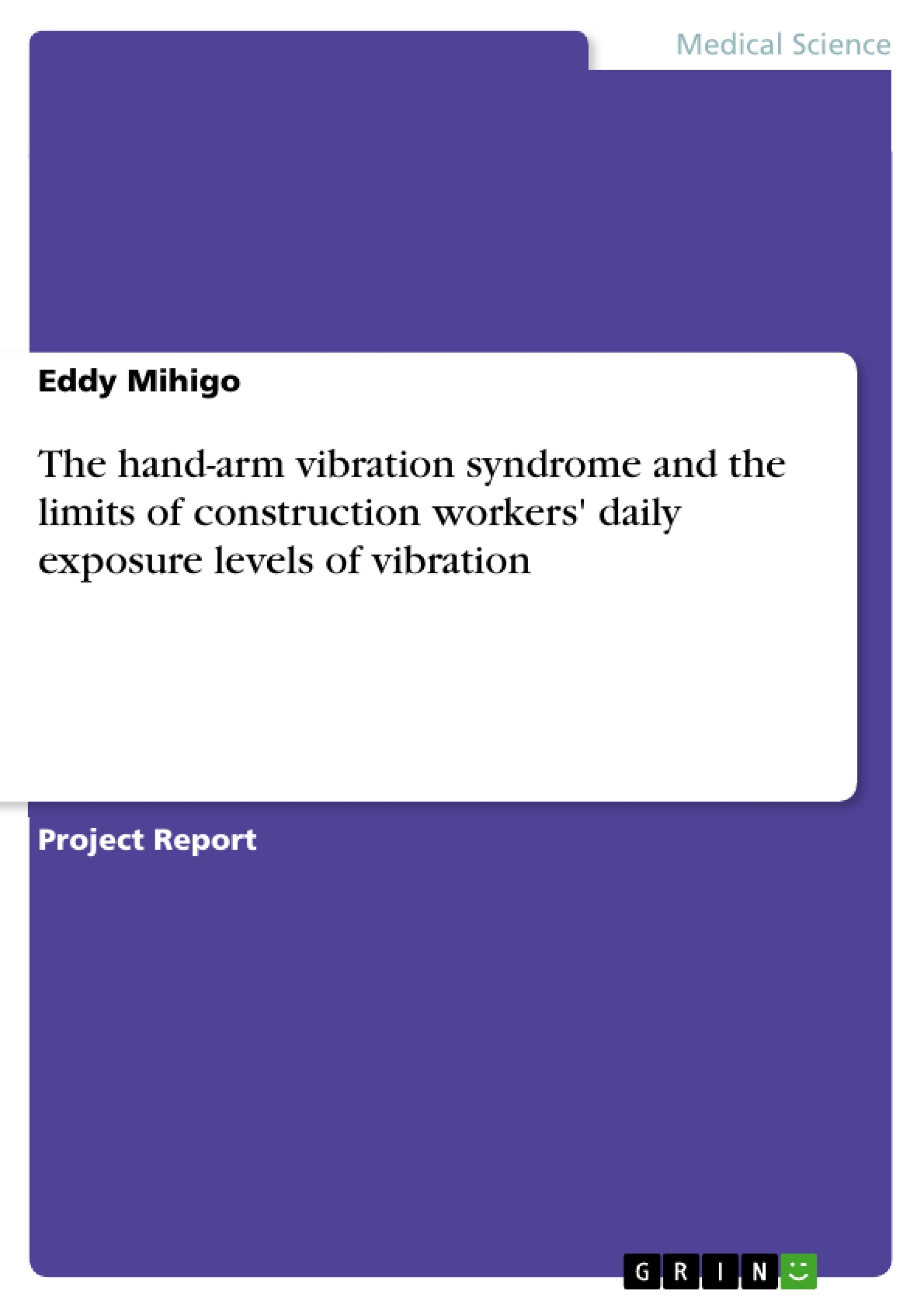This research project is about the Hand-Arm Vibration Syndrome (HAVS) which construction workers suffer from. Are the daily exposure levels of vibration to which construction workers are exposed within acceptable limits? HAVS is a group of symptoms related to the use of equipment and tools that vibrate. Symptoms range from vascular and neurological to musculoskeletal, and affect different parts of the hand-arm system.
Vibration is the oscillatory motion of bodies. It is divided into hand transmitted vibration, which is vibration entering the body through hands, and whole-body vibration, which enters the body when it is supported by some vibrating surface. There are over 8 million workers that are exposed to vibration, and as an occupational hazard, it is not given much attention in Botswana and in most parts of the developing world.
A quantitative cross-sectional study design was used since there were different groups whose results were compared. The vibrometer was be used to quantify the daily vibration levels in each sample population, and the questionnaire distributed provided additional information as to the presence of symptoms or history of any discomfort resulting from the type of work. The population of interest includes the workers at a construction site within the University of Botswana, and these were divided into 5 groups, each group comprised 2 to 3 workers selected systematically, from whom data was collected depending on the tools available on the construction site. This means that the study population was 15.
When one looks at its negative effects on the human body, which range from simple nausea to HAVS, it is safe to say that vibration is not getting the attention it needs. Various technical developments in society have led to an increase in the number and types of sources of vibration to which people are exposed.
Inhaltsverzeichnis (Table of Contents)
- INTRODUCTION AND BACKGROUND
- Introductory statement.
- Problem Statement
- Problem Analysis
- Hand-Arm vibration
- Whole body vibration
- Environmental factors.
- Worker related factors
- Justification
- LITERATURE REVIEW
- Hand Transmitted Vibration
- Global Situation and studies
- Situation and studies in developing nations
- Situation and studies carried out in South Africa
- Whole Body Vibration.
- Global Situation and studies
- Situation and studies in developing countries
- Concluding remarks
- OBJECTIVES
- METHODOLOGY
- Study Design.
- Sample selection
- The HAVpro Vibrometer.
- Measurement for hand held tools (Hand transmitted vibration).
- Truck drivers and forklift operators (Whole body vibration).
- Additional calculations.
- Hand transmitted vibration
- Whole body vibration.
- Questionnaire.
- Ethical considerations..........\li>
- Data management
- Data presentation.
- Quality control and Quality assurance
- Limitations of the study.
- RESULTS
- Pilot study results
- Main study results........
- Questionnaire
- Data analysis........
- Hand transmitted vibration
- Whole body vibration.
- DISCUSSION OF RESULTS.
- Pilot study..
- Main study.
- Questionnaire
- Hand transmitted vibration
- Whole body vibration.
Zielsetzung und Themenschwerpunkte (Objectives and Key Themes)
The purpose of this research project is to investigate the daily exposure levels to hand transmitted and whole body vibration experienced by construction workers at a construction site within the University of Botswana. This study aims to contribute to the understanding of occupational health hazards associated with vibration exposure and the potential for mitigating these risks.
- Hand-arm vibration and whole body vibration exposure in construction workers
- Health risks associated with vibration exposure
- Assessment of vibration exposure levels in a construction site
- Comparison of vibration exposure levels across different job roles
- Recommendations for mitigating vibration exposure and promoting worker safety
Zusammenfassung der Kapitel (Chapter Summaries)
The study begins with an introduction and background information on the problem of hand-arm vibration and whole body vibration exposure in construction workers. It presents the problem statement, analyzes the problem in terms of its causes and effects, and outlines the rationale for the study. The literature review section provides a comprehensive overview of the existing research on the topic, both globally and in developing countries, including South Africa.
Chapter 3 details the study's objectives, which are to assess vibration exposure levels, identify risk factors, and explore the effectiveness of potential mitigation strategies. The methodology chapter describes the study design, sampling procedure, data collection methods, and data analysis techniques. This includes information on the use of the HAVpro Vibrometer, questionnaires, and ethical considerations. The results chapter presents the findings from both the pilot study and the main study, including data on vibration exposure levels and worker characteristics.
The discussion chapter interprets the results in relation to existing literature and explores the implications of the findings for occupational health and safety practices. Finally, the study concludes with a summary of the key findings, recommendations for future research and practice, and the potential for improving worker health and well-being.
Schlüsselwörter (Keywords)
This research project focuses on occupational health hazards, specifically hand-arm vibration and whole body vibration exposure in construction workers. The study aims to identify and quantify vibration exposure levels, assess associated health risks, and explore potential mitigation strategies. Key research focuses include hand-arm vibration, whole body vibration, construction workers, occupational health, risk assessment, mitigation strategies, and worker safety.
- Citar trabajo
- Eddy Mihigo (Autor), 2010, The hand-arm vibration syndrome and the limits of construction workers' daily exposure levels of vibration, Múnich, GRIN Verlag, https://www.grin.com/document/502602



